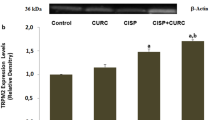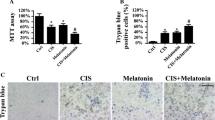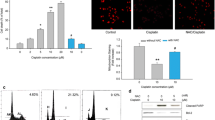Abstract
The paclitaxel (PAX) and melatonin (MLT)–mediated mitochondria reactive free oxygen radical (miROS) generations via the influx of excessive Ca2+ and Zn2+ induce tumor cell death and apoptosis. However, a presence of resistance was demonstrated against the PAX treatment in the tumor cells. The stimulation of TRPM2 may increase the anticancer action of PAX after the treatment of MLT. We investigated the stimulating role of PAX with/without MLT on the excessive Ca2+ influx and miROS generation–mediated human laryngeal squamous cancer (Hep2) cell death through the stimulation of TRPM2. The Hep2 cells were divided into four groups as control, MLT (1 mM for 2 h), PAX (50 μM for 24 h), and PAX + MLT. In some experiments, we induced additional subgroups such as PAX+ACA and PAX+2APB. The stimulation of TRPM2 induced the increase of TRPM2 current densities, lipid peroxidation, cytosolic ROS, miROS, cytosolic Ca2+, and Zn2+ values in the Hep2 cells after the treatment of PAX, although their values were decreased by the treatment of MLT and TRPM2 antagonists (ACA and 2APB). In addition, the PAX induced apoptosis and cell death via upregulation of caspases and downregulation of antioxidant glutathione peroxidase and glutathione in the cells. The treatment of PAX increased protein band expression values of TRPM2, PARP-1, and caspase 3 and 9 in the Hep2. The increased expression, apoptotic, and cell death values were not affected by the treatment of MLT. In conclusion, PAX induced the increase of Hep2 cell death via upregulations of TRPM2 and Zn2+, although its downregulation via the treatment of MLT did not change the antitumor action of PAX.










Similar content being viewed by others
Data Availability
The present data and analysis results are included in the current study.
References
Global Cancer Observatory. International Agency for Research on Cancer. WHO. Available at: https://gco.iarc.fr/. Accessed 24 Sept 2021
Koroulakis A, Agarwal M (2021) Laryngeal cancer. [Updated 2021 Aug 11]. In: StatPearls [Internet]. Treasure Island: StatPearls Publishing. Available from: https://www.ncbi.nlm.nih.gov/books/NBK526076/. Accessed 24 Sept 2021
Liu HC, Chen GG, Vlantis AC, Tong MC, van Hasselt CA (2008) Chemotherapy for laryngeal cancer–an apoptotic approach. Curr Drug Targets 9(10):878–886. https://doi.org/10.2174/138945008785909257
Jiang Q, Liu S, Hou L, Guan Y, Yang S, Luo Z (2020) The implication of LncRNA MALAT1 in promoting chemo-resistance of laryngeal squamous cell carcinoma cells. J Clin Lab Anal 34(4):e23116. https://doi.org/10.1002/jcla.23116
Gökçe Kütük S, Gökçe G, Kütük M, Gürses Cila HE, Nazıroğlu M (2019) Curcumin enhances cisplatin-induced human laryngeal squamous cancer cell death through activation of TRPM2 channel and mitochondrial oxidative stress. Sci Rep 9(1):17784. https://doi.org/10.1038/s41598-019-54284-x
Öztürk Y, Günaydın C, Yalçın F, Nazıroğlu M, Braidy N (2019) Resveratrol enhances apoptotic and oxidant effects of paclitaxel through TRPM2 channel activation in DBTRG glioblastoma cells. Oxid Med Cell Longev 2019:4619865. https://doi.org/10.1155/2019/4619865
Sun H, Liu Y, Bai X et al (2018) Induction of oxidative stress and sensitization of cancer cells to paclitaxel by gold nanoparticles with different charge densities and hydrophobicities. J Mater Chem B 6(11):1633–1639. https://doi.org/10.1039/c7tb03153j
Wang J, Fan J, Gao W et al (2020) LY6D as a chemoresistance marker gene and therapeutic target for laryngeal squamous cell carcinoma. Stem Cells Dev 29(12):774–785. https://doi.org/10.1089/scd.2019.0210
Dong JR, Guo N, Zhao JP, Liu PD, Feng HH, Li Y (2013) Inhibition of nemo-like kinase increases Taxol sensitivity in laryngeal cancer. Asian Pac J Cancer Prev 14(12):7137–7141. https://doi.org/10.7314/apjcp.2013.14.12.7137
Xiang S, Dauchy RT, Hoffman AE et al (2019) Epigenetic inhibition of the tumor suppressor ARHI by light at night-induced circadian melatonin disruption mediates STAT3-driven paclitaxel resistance in breast cancer. J Pineal Res 67(2):e12586. https://doi.org/10.1111/jpi.12586
Lissoni P, Barni S, Mandalà M et al (1999) Decreased toxicity and increased efficacy of cancer chemotherapy using the pineal hormone melatonin in metastatic solid tumour patients with poor clinical status. Eur J Cancer 35(12):1688–1692. https://doi.org/10.1016/s0959-8049(99)00159-8
Kerkhofs M, Bittremieux M, Morciano G et al (2018) Emerging molecular mechanisms in chemotherapy: Ca2+ signaling at the mitochondria-associated endoplasmic reticulum membranes. Cell Death Dis 9(3):334. https://doi.org/10.1038/s41419-017-0179-0
Rivera E, Gomez H (2010) Chemotherapy resistance in metastatic breast cancer: the evolving role of ixabepilone. Breast Cancer Res. 12(Suppl 2):S2. https://doi.org/10.1186/bcr2573
El-Sokkary GH, Ismail IA, Saber SH (2019) Melatonin inhibits breast cancer cell invasion through modulating DJ-1/KLF17/ID-1 signaling pathway. J Cell Biochem 120(3):3945–3957. https://doi.org/10.1002/jcb.27678
Kumar VS, Gopalakrishnan A, Naziroğlu M, Rajanikant GK (2014) Calcium ion–the key player in cerebral ischemia. Curr Med Chem 21(18):2065–2075. https://doi.org/10.2174/0929867321666131228204246
Pariente R, Bejarano I, Espino J, Rodríguez AB, Pariente JA (2017) Participation of MT3 melatonin receptors in the synergistic effect of melatonin on cytotoxic and apoptotic actions evoked by chemotherapeutics. Cancer Chemother Pharmacol 80(5):985–998. https://doi.org/10.1007/s00280-017-3441-3
Uguz AC, Cig B, Espino J et al (2012) Melatonin potentiates chemotherapy-induced cytotoxicity and apoptosis in rat pancreatic tumor cells. J Pineal Res 53(1):91–98. https://doi.org/10.1111/j.1600-079X.2012.00974.x
Scherzed A, Hackenberg S, Froelich K et al (2015) Effects of salinomycin and CGP37157 on head and neck squamous cell carcinoma cell lines in vitro. Mol Med Rep 12(3):4455–4461. https://doi.org/10.3892/mmr.2015.3981
Li XQ, Ren J, Wang Y et al (2021) Synergistic killing effect of paclitaxel and honokiol in non-small cell lung cancer cells through paraptosis induction. Cell Oncol (Dordr) 44(1):135–150. https://doi.org/10.1007/s13402-020-00557-x
Ji D, Luo ZW, Ovcjak A, et al. (2021) Role of TRPM2 in brain tumours and potential as a drug target. Acta Pharmacol Sin. https://doi.org/10.1038/s41401-021-00679-4. Epub ahead of print.
Nazıroğlu M, Braidy N (2017) Thermo-sensitive TRP channels: novel targets for treating chemotherapy-induced peripheral pain. Front Physiol 8:1040. https://doi.org/10.3389/fphys.2017.01040
Ertilav K, Nazıroğlu M, Ataizi ZS, Braidy N (2019) Selenium enhances the apoptotic efficacy of docetaxel through activation of TRPM2 channel in DBTRG glioblastoma cells. Neurotox Res 35(4):797–808. https://doi.org/10.1007/s12640-019-0009-5
Almasi S, Kennedy BE, El-Aghil M et al (2018) TRPM2 channel-mediated regulation of autophagy maintains mitochondrial function and promotes gastric cancer cell survival via the JNK-signaling pathway. J Biol Chem 293(10):3637–3650. https://doi.org/10.1074/jbc.M117.817635
Espino J, Bejarano I, Paredes SD, Barriga C, Rodríguez AB, Pariente JA (2011) Protective effect of melatonin against human leukocyte apoptosis induced by intracellular calcium overload: relation with its antioxidant actions. J Pineal Res 51(2):195–206. https://doi.org/10.1111/j.1600-079X.2011.00876.x
Reiter RJ, Tan DX, Paredes SD, Fuentes-Broto L (2010) Beneficial effects of melatonin in cardiovascular disease. Ann Med 42(4):276–285. https://doi.org/10.3109/07853890903485748
Koşar PA, Nazıroğlu M, Övey İS, Çiğ B (2016) Synergic effects of doxorubicin and melatonin on apoptosis and mitochondrial oxidative stress in MCF-7 breast cancer cells: involvement of TRPV1 channels. J Membr Biol 249(1–2):129–140. https://doi.org/10.1007/s00232-015-9855-0
Galley HF, McCormick B, Wilson KL, Lowes DA, Colvin L, Torsney C (2017) Melatonin limits paclitaxel-induced mitochondrial dysfunction in vitro and protects against paclitaxel-induced neuropathic pain in the rat. J Pineal Res 63(4):e12444. https://doi.org/10.1111/jpi.12444
Sadiq Z, Varghese E, Büsselberg D (2020) Cisplatin’s dual-effect on the circadian clock triggers proliferation and apoptosis. Neurobiol Sleep Circadian Rhythms 9:100054. https://doi.org/10.1016/j.nbscr.2020.100054
Tseng HH, Vong CT, Kwan YW, Lee SM, Hoi MP (2016) TRPM2 regulates TXNIP-mediated NLRP3 inflammasome activation via interaction with p47 phox under high glucose in human monocytic cells. Sci Rep 6:35016. https://doi.org/10.1038/srep35016
Celik O, Nazıroğlu M (2012) Melatonin modulates apoptosis and TRPM2 channels in transfected cells activated by oxidative stress. Physiol Behav 107(3):458–465. https://doi.org/10.1016/j.physbeh.2012.09.013
Ertilav K (2019) Levetiracetam modulates hypoxia-induced inflammation and oxidative stress via inhibition of TRPV1 channel in the DBTRG glioblastoma cell line. J Cell Neurosci Oxid Stress 11(3):885–894. https://doi.org/10.37212/jcnos.715227
Akyuva Y (2020) Clostridium botulinum neurotoxin A inhibits DBTRG glioblastoma cell proliferation and TRPV1 channel signaling pathways. J Cell Neurosci Oxid Stress 12(1):903–913. https://doi.org/10.37212/jcnos.809635
Nazıroğlu M, Lückhoff A (2008) A calcium influx pathway regulated separately by oxidative stress and ADP-Ribose in TRPM2 channels: single channel events. Neurochem Res 33(7):1256–1262. https://doi.org/10.1007/s11064-007-9577-5
Bao L, Chen SJ, Conrad K, Keefer K, Abraham T, Lee JP et al (2016) Depletion of the human ion channel TRPM2 in neuroblastoma demonstrates its key role in cell survival through modulation of mitochondrial reactive oxygen species and bioenergetics. J Biol Chem 291(47):24449–24464. https://doi.org/10.1074/jbc.M116.747147
Venegas C, García JA, Escames G et al (2012) Extrapineal melatonin: analysis of its subcellular distribution and daily fluctuations. J Pineal Res 52(2):217–227. https://doi.org/10.1111/j.1600-079X.2011.00931.x
Wang X, Sirianni A, Pei Z, Cormier K, Smith K, Jiang J et al (2011) The melatonin MT1 receptor axis modulates mutant Huntingtin-mediated toxicity. J Neurosci 31(41):14496–14507. https://doi.org/10.1523/JNEUROSCI.3059-11.2011
Zhang X, Zhang S, Zhu S et al (2014) Identification of mitochondria-targeting anticancer compounds by an in vitro strategy. Anal Chem 86(11):5232–5237. https://doi.org/10.1021/ac500918g
Kidd JF, Pilkington MF, Schell MJ et al (2002) Paclitaxel affects cytosolic calcium signals by opening the mitochondrial permeability transition pore. J Biol Chem 277(8):6504–6510. https://doi.org/10.1074/jbc.M106802200
McCormick B, Lowes DA, Colvin L, Torsney C, Galley HF (2016) MitoVitE, a mitochondria-targeted antioxidant, limits paclitaxel-induced oxidative stress and mitochondrial damage in vitro, and paclitaxel-induced mechanical hypersensitivity in a rat pain model. Br J Anaesth 117(5):659–666. https://doi.org/10.1093/bja/aew309
Sprouse AA, Herbert BS (2014) Resveratrol augments paclitaxel treatment in MDA-MB-231 and paclitaxel-resistant MDA-MB-231 breast cancer cells. Anticancer Res 34(10):5363–5374
Lissoni P, Tancini G, Barni S, Paolorossi F, Ardizzoia A, Conti A, Maestroni G (1997) Treatment of cancer chemotherapy-induced toxicity with the pineal hormone melatonin. Support Care Cancer 5(2):126–129. https://doi.org/10.1007/BF01262569
Wang YM, Jin BZ, Ai F, Duan CH, Lu YZ, Dong TF, Fu QL (2012) The efficacy and safety of melatonin in concurrent chemotherapy or radiotherapy for solid tumors: a meta-analysis of randomized controlled trials. Cancer Chemother Pharmacol 69(5):1213–1220. https://doi.org/10.1007/s00280-012-1828-8
Funding
The present study was financially supported by the BSN Health, Analyses, Innovation, Consultancy, Organization, Agriculture, Industry and Trade Limited Company, Isparta, Turkey. (The number of the project is 2021–02. The owner of the project is Dr. YÇ Kumbul.)
Author information
Authors and Affiliations
Contributions
Dr. M Nazıroğlu and Dr. YÇ Kumbul formulated the present hypothesis and the main manuscript text. The cell culture, antioxidant, and cell viability analyses in the current study were performed in the 5th International Brain Research School, 16 and 22 November 2020, Isparta, Turkey, by Dr. YÇ Kumbul. (http://2020.brs.org.tr/). The remaining analyses were performed by Dr. M Nazıroğlu.
Corresponding author
Ethics declarations
Ethics Approval and Consent to Participate
There are no human and animal samples in the current study.
Conflict of Interest
The authors declare no competing interests.
Additional information
Publisher's Note
Springer Nature remains neutral with regard to jurisdictional claims in published maps and institutional affiliations.
Rights and permissions
About this article
Cite this article
Kumbul, Y.Ç., Nazıroğlu, M. Paclitaxel Promotes Oxidative Stress–Mediated Human Laryngeal Squamous Tumor Cell Death through the Stimulation of Calcium and Zinc Signaling Pathways: No Synergic Action of Melatonin. Biol Trace Elem Res 200, 2084–2098 (2022). https://doi.org/10.1007/s12011-022-03125-6
Received:
Accepted:
Published:
Issue Date:
DOI: https://doi.org/10.1007/s12011-022-03125-6




